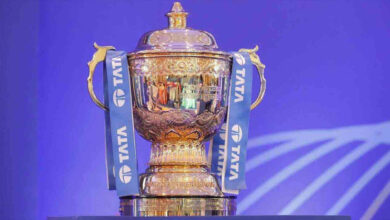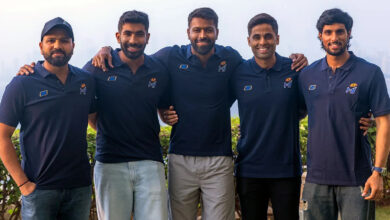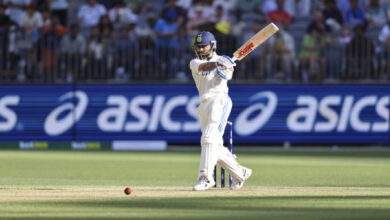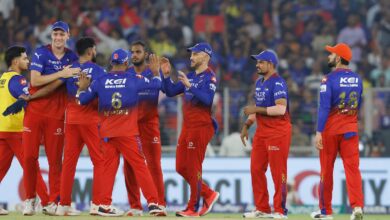What happens when Santosh Trophy comes to a football-crazed Malappuram in Kerala?

Eighty minutes into a scruffy encounter between Kerala and West Bengal at Manjeri’s Payyanad stadium, amidst a billowing mass of humanity, the fans have not stopped chanting and the bands have not stopped playing. Seized a ceaseless flow of energy, the chants become louder and the beats become thunderous as hosts Kerala search frantically for a deadlock-breaking goal in the Santosh Trophy game on a soggy outfield, where the players slipped and stumbled.
The self-designated conductor of the band is Bhaskar ettan (elder brother), a spry man in his late fifties in a Castro hat, the ends of his long hair hugging the shoulders. He has elastic wrs that he contorts to his will. Bhaskar ettan used to play the drums for a circus group. “When the elephants played cricket and leopards leapt around,” he says, bursting into peals of laughter. He wanted to be a footballer, but now satisfies himself playing drums on the football field around Malappuram, the most football-mad drict of the football-mad state.
There are other musicians in the 25,000-strong crowd that has converged to the suburb in Manjeri from dant corners of Kerala’s Malappuram drict (from Ponnani and Vazhikkadavu) and from beyond the borders of the drict (Thrissur and Kozhikode), with banners and crackers, whles and drums, passion and fervour. The stadium is not connected bus, but just for this occasion, a couple of state transport buses have been arranged to ferry people from the neighbouring town of Perinthalmanna.
Local boy P N Noufal celebrates after scoring a goal. (Sandip G/Kerala Football Association)
The stretch has no human settlement. There are no buildings or tea stalls, not even a streetlight, only trees and canopies as far as the eyes go. But on match days, it turns into a shrine for football pilgrims of all age-groups.
A bunch of teenagers, some in brand-new football jerseys, are here with the drums and clarinets they stole from the school band. A local party member had snuck out of an important meeting, lying that he had tested positive for the coronavirus — the face mask is his weapon of disguise. Majeed, a man in his late 20s, who works in Kuwait, is on leave for three weeks “to watch the tournament peacefully” with his friends — he lied to his boss that his mother was sick.
When football fever grips, everything else pales. “How can I focus on my work when my hometown is hosting a football match? If you lose a job, you will find another; but if you miss a game, you can never recreate that experience,” Majeed reasons.
All these sacrifices are for the Santosh Trophy, a tournament that lost its grandeur and glamour long ago — a national tournament that faces an exential pang. Forget the country’s best footballers, even the second best hardly appear for Santosh Trophy, even if they are not tied club duty. But it never fails to fascinate the audience in Kerala. To them, it sits alongside the European league competitions, the Champions League, the World Cup and Euros, and now the Indian Super League (ISL) in fervour. Most of the 25,000 seats for the Kerala versus Bengal game were sold out days in advance, most in the audience have purchased season tickets. Even those matches that don’t feature the home side are reasonably well-attended.
In a sense, the fans here are football citizens of the world. Their worlds jostle between Brazil and Argentina, Real Madrid and Barcelona, Kerala Blasters and Gokulam FC, Manchester United and Liverpool. The heroes that adorn their walls range from Criano Ronaldo and Lionel Messi to Sunil Chhetri and Abdul Sahal Samad, the brightest contemporary footballing talent from Kerala. More than those of politicians and actors, it’s the faces of Ronaldo and Messi that peer at you from the shops, T-shirts, and even sling bags. Textile shops have an enormous collection of jerseys, not just of the elite players of the elite clubs, but even those of players from little-known European clubs such as Watford and Osasuna.
No Santosh Trophy match strikes a bigger emotional chord than those between Kerala and West Bengal, two erstwhile powerhouses, two cultures that sentimentally cling onto the glory days of football when they competed in churning out the best players for the country. Bengal has the bragging rights — they have won the trophy a record 32 times; Kerala has triumphed just six times.
Back on the field, the moment the crowd has been waiting for finally arrives. Local boy P N Noufal slips the ball past the onrushing goalkeeper to the bottom-right corner, sending the crowd into a frenzy that would hang in the air all night. They let a roar so loud that it would have been heard as far as the Unity Hills, a tour haunt that’s some 10 km from Payyanad.
Bhaskarettan begins to pound his drums with the frenzy of a temple oracle, but his beats get drowned in the percussion of 25,000 pairs of clapping hands. Plumes of yellow and grey flares from smoke-grenades wrap the stands. The banners wave like mainsails in a storm. Policemen rush to the iron barricades to prevent a few potential pitch invaders. And then, the crowd sings that tweaked version of a staple political slogan on a loop: “Vanganaatile vankanmare, thotta charithram njangakilla!” Literally translated: “Len, the fools of Bengal, we don’t have a hory of losing.”
The scoreline: 2-0.
For the next hour, from the last goal to the moment the team bus leaves, the celebrations go on — dancing, chanting, singing, picking souvenirs, clicking selfies in the backdrop of the gallery that’s painted green and yellow, and thronging the team bus as it leaves. The stadium, in the wilderness of columns of teak, rubber and mahogany, is now an island of joy — an independent, football-obsessed planet.
“It’s the night to celebrate,” shouts Bhaskarettan, giving his drums a loud thud.
It’s not different from what Brazil’s greatest playwright Nelson Rodrigues wrote about the country’s fixation with football. “Abroad, when you want to learn about people, you examine their fiction. In Brazil, football plays the role of fiction.”
Rodrigues’s Brazil might as well have been Manjeri or Malappuram.
Minutes before the match began, as dusk descends over the Payyanad Stadium, Mujeeb, in his 20s, and his friends begin their search for a quiet corner where they can offer the evening prayers. They find a verandah in the adjoining building, where they spread the mat. The stadium falls silent, as the muezzin calls for the Maghrib from the Pandulur Masjid.
Prayers offered, Mujeeb, a kerchief wrapped over his head, and his friends, rush back to their seats. The Kerala team has just begun to practise and he can’t hide his excitement. “Look at the pony-tailed left-back Saheef, he is quite fast… Captain Jijo Joseph has a killer back-heel…”
In his enthusiasm, he has forgotten to break the fast. A friend reminds him and he opens a shiny polythene bag filled with local delicacies — onion samoosas (not samosa), stuffed pathiri, dates and almonds. He dributes some to those sitting around him. So do many others in the stadium as the galleries, for a few minutes, host a full-scale iftar party.
Both football and faith are integral to the locals. There are as many football grounds as mosques and temples in Malappuram — from grass-turfs to asphalt ones, from concrete to cobblestone, from sand to mud grounds.
Mujeeb adds: “We play football even inside our house. The moment we see a piece of land, the first thought is, can we play here?”
Mujeeb is from Mampad, the seven-a-side or Sevens football hub of Kerala, some 30 km from Manjeri. Sevens are Kerala’s version of Brazil’s pelada, though without much rule-tweaks. Sevens was once much-maligned the puritans of the conventional 11-a-side brand. But now, with Sevens becoming a supply chain to the state side, after the emergence of Anas Edathodika, Ashique Kuruniyan, Mohammad Rafi and C K Vineeth, it has shed its stigma.
For Mujeeb, it does not matter whether they are playing five-, seven- or eleven-a-side. “I pray five times a day and I used to play football almost as many times a day,” he says. The routine has been drilled into his mind since he was a child. “You play in the morning, then go to school, come back, then play again till the evening prayers, and then play for half an hour more,” he says, ruing that the government job he does in his village in Edappal has eaten into his football-playing hours.
Many of the Sevens players play out of passion. Only those in the top teams earn a sustainable income. Their teams comprise mostly Sudanis — the catch-all term for all Africans that’s without any pejorative undertones — who are the most sought-after stock in the Sevens league.
“Football is a slice of our lives,” says Salam Haji, fondly called Hajikka (elder brother Haji). He is accompanied two of his grandchildren to the stadium. He introduces the elder one as “Ronaldo kuttan” and the other as “Messi mon” (kuttan and mon are terms of endearment reserved for little boys). Hajikka wanted to name one of his four sons Zico, after the Brazilian great, but his wife would have none of that.
A football tragic who boarded a train to Madgaon in Goa for the ISL final between Kerala Blasters and FC Hyderabad and lingered on though he did not manage a ticket for the game, Hajikka says he teaches his grandchildren verses from the holy Quran as well as the rules of the game. “Both sports and religion play an important role in our lives. Here, parents don’t stop children from going to two places — the mosque and the grounds,” he says.
He then strikes a moralic position: “It’s better to play football than to idle around eating, smoking or watching movies. It teaches you discipline and makes you strong,” he says, proudly flaunting his taut biceps.
A football match is also where new friends are made and old acquaintances dusted up. Hajikka has stumbled onto a dant cousin of his, whom he last met during an I-League match of Gokulam FC at the same ground last year.
The day after the match, Manjeri wakes up late. The brling business town — long past its glory days as the headquarters and military centre of the Kingdom of Mysore under Tipu Sultan or its significance as centre of politics during India’s struggle for Independence — is still hung over from the previous night’s football-induced intoxication. Some of the restaurants have skipped the breakfast hours; some of the 24-hour medical shops in the vicinity of the Manjeri Medical College stayed shut till noon. Just a handful of road-side tea vendors are open, and they complain of dull business. “The day after any match, our business is always dull. There is hardly anyone on the streets,” says a tea vendor, between wide yawns.
Beside the stall, under a bright-blue shamiana, a group of teenage football fans, who were part of the 25,000-strong crowd at the Payyanad Stadium, sit reminiscing the night before — the euphoria as the ball pierced into the net and the helpless shriek of the Bengal goalkeeper who wore a pink jersey “like (Italian footballer) Gigi Buffon”.
One of them had his pair of new sneakers stamped a fellow spectator. Another is still wearing his shirt that got torn when he leapt from his seat to celebrate. Another shows a recent selfie with P N Noufal. “Noufal ikka is my friend. He is my uncle’s neighbour,” he says, proudly stroking his chin.
They recall how the Kerala coach knelt onto the turf and kissed it after the team’s win, their futile attempt to leap over the barricades that were fastened to each other with ropes that resembled pythons, the pride they felt when the Kerala players waved and applauded them for their ceaseless support. They also speak about the countless goal-scoring chances the home side’s strikers fluffed, the referee who they felt was a “moyanthan (stupid)”.
The group is so ecstatic that they decide to bunk their tuition class and head to an abandoned piece of land behind the Manjeri Medical College for a game of football. The seven of them divide themselves into two groups — three on one side and four on the other. How will that work? “Come here after 10 minutes. There will be more than 11 players in a team,” says one of them.
Sure enough, barely five minutes later, the ground is filled with teenagers running and spinning, passing and dribbling. Some play in sneakers or trainers, others barefoot; some in shorts, others in jeans and lungi.
Not far away, on a street barely wide enough for a car to pass, under dangling overhead wires, a bunch of adolescents are running behind a ball. They bump into kerbs and walls and into each other. Somewhere in the dance, you can hear the pounding of Bhaskar ettan’s drums.







